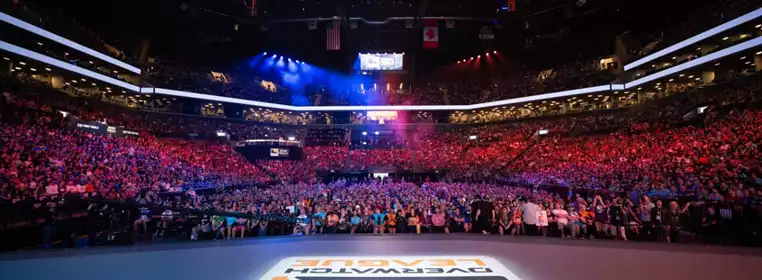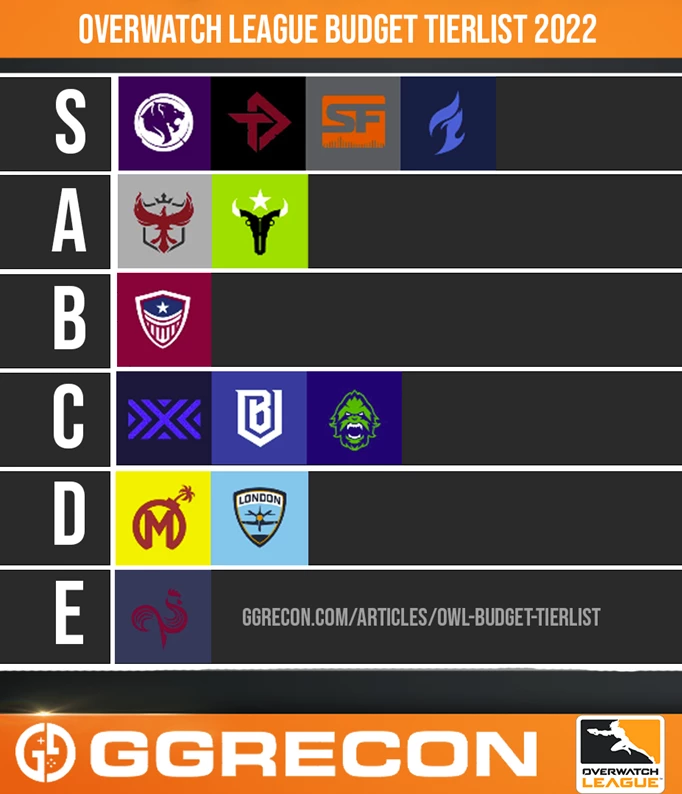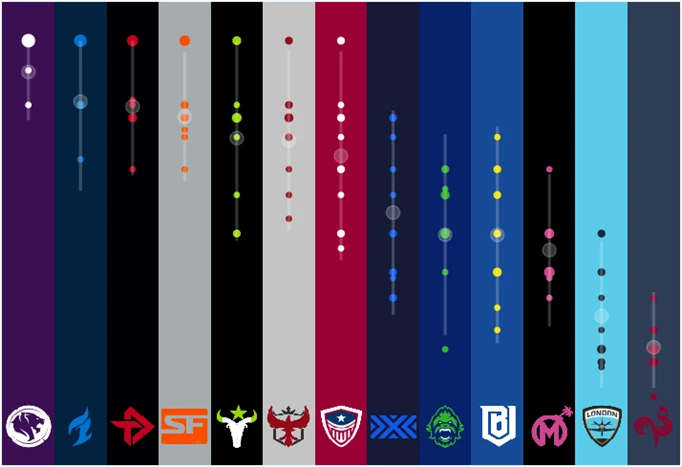OWL Budget Tier List - August 2022

As a fan in the Overwatch League (OWL), team budget transparency is hard to come by. While the League used to put out an average and median salary in its annual player contract status article, it ceased to do so in its last update, and our most recent official status goes back to season 3.
Moreover, it never indicated which teams were spending the most or the least, making it impossible for fans to discuss which organisations were willing to spend for their team’s success or who were using their budget effectively.
In an effort to close this gap, we asked twelve experts with inside information on OWL budgets and the transfer market to submit their best guestimations on the player salary and buyout budget for each team in the North American region. We aggregated these submissions into one OWL Budget Tier List.

 Click to enlarge
Click to enlargeTier explanations
Some of our sources graciously provided additional evidence-based insights which allowed us to create an approximation of the money spent for each tier of the OWL Budget Tier List.
S Tier - (estimated around USD $1,200,000+) Teams in this tier generally have some players on their roster which commanded a large buyout and considerable salary. The highest value players in these teams can be expected to make around $200,000 - $250,000 with buyout prices ranging at about the same value or higher. Notable outliers appear to exist, and player performance will not always correlate with the salary they command. Experts have highlighted some of the San Francisco Shock players among these.
A Tier - (estimated around USD $1,000,000) - Teams in this tier show many similar attributes to S Tier teams. Notably, neither Joseph "Lep" Cambriani nor Tomas "Doge" Kongsøre had been announced as signings for the Houston Outlaws and are unlikely to have been part of the estimation of our experts. Some of our sources stated that while they believe the Atlanta Reign still pay very competitive salaries, the buyout received for the sale of Oh "Pelican" Se-hyun is likely so significant as to bump them down into A Tier.
B Tier - (estimated around USD $800,000) - While the Justice have long been considered to be one of the higher spending teams by the public, our experts estimate them to sit right in the middle of the North American region. Some of our sources advised that the discrepancy likely stems from the overestimation of Jang "Decay" Gui-un’s and Kim "Mag" Tae-sung’s salaries and the average public estimation of the median and average pay of the Justice’s roster is also likely to be too high.
C Tier - (estimated around USD $650,000) - Teams in this bracket have very different spending profiles and are hard to generalise. In our estimation, they are also the most likely to be inaccurately placed.
The Uprising still runs an academy program which adds additional complexity to their estimation both in buyouts paid and earned. They’ve historically been a team with an economical approach to roster building. That said, they also have one of the bigger rosters in Overwatch League.
Some of our sources shared that they believe the Excelsior to have some players such as Kim "Kellan" Min-jae and Kim "Yaki" Jun-ki on very competitive salaries given the competition for them in the pre-season marketplace. Moreover, neither the signing of An "ANSOONJAE" Soon-jae nor the departure of Seo "Myunb0ng" Sang-min are likely to have been part of the consideration of our experts.
The Titans are said to have spent a little more this year than during the last season though the range of placements of our submissions seems to indicate that there is no clear consensus on the spending of this team.
D Tier - (estimated around USD $500,000)
Two teams which have used their limited budget effectively are the Florida Mayhem and the London Spitfire. Notably, the entire estimated budget of these teams’ player salaries and buyouts are in sum at best equal to one top-tier player in the Overwatch League when adding their salary and buyout. Teams in this tier almost never pay buyouts themselves and rely on effective usage of their spending dollar.
Our experts shared that they believe the Mayhem to have played the market most effectively, pulling the trigger on trades that increases their value with limited internal resistance. Particularly the signing of Ham "SOMEONE" Jeong-wan is seen by some insiders as a bargain deal and a major error by multiple teams during the scouting process in the pre-season which allowed the Mayhem to recruit the tank talent.
The Spitfire are housed around the Cloud9 headquarters in Los Angeles and are therefore bound to California’s pay requirement of $62,500 USD, which is noticeably higher than the OWL-required minimum salary of $50,700. It follows that they are likely to be sitting at around $500,000 for their seven players.
E Tier - (estimated around $330,000)
Not only does the Paris Eternal only have the minimum amount of players required by the Overwatch League in six active full-season contracts, according to our insiders they are also only paying close to minimum salary and almost every buyout amount is considered prohibitive in them picking up a new signing.

 Click to enlarge
Click to enlargeDots represent each source's ranking. The size of the circle indicates how many ranked it at that tier. By fishghost
Methodology
We reached out to various experts within the Overwatch League space, starting mid-July until the second week of August 2022, to give us their best estimation of the budget of teams in the North American region. We chose this approach as asking for any more detail would’ve likely cut the number of informed submissions down considerably, as the resistance to share this type of information is still considerable in the Overwatch esports space. Source anonymity was given for similar reasons.
Experts were free to create as many tiers as they felt necessary and we normalised their submissions into six tiers in the final version. We consolidated those submissions with equal weight into one tier list. We also created a second graphic to give readers an idea about the general spread of opinions while maintaining anonymity for our sources.
While the result is the most comprehensive player salary and budget estimation released to the public yet, the format comes with a considerable amount of weaknesses.
Weaknesses
The approach has notable weaknesses and leaves out important factors that impact the value of a blanket dollar offer a team may make to a player. As such, the post-tax amount the player gets to keep based on the local tax rate, whether or not teams cover housing, provide food stipends or other lifestyle benefits such as gym access or transportation have not been factored in, as they prove difficult to evaluate.
These factors are likely to be part of each player’s decision to choose an organisation to play for, but they felt outside the scope of insight of what we could reasonably expect our insiders to have. Additional organisational costs such as coaching and staff salaries, the team facility, and fees expected to acquire visas for a player if necessary have also not been factored in for the same reason.
Another weakness appears to be the approach of a snapshot evaluation for this season alone. While some teams may still be benefiting from having acquired players for large buyouts in past seasons, these haven’t been normalised into these estimations. An example of the inverse are teams like the Atlanta Reign, who likely received a considerable buyout from the Houston Outlaws for the sale of Oh "Pelican" Se-hyun which we did ask our insiders to factor in. We hope to eventually rectify this inaccuracy by providing this type of information over several seasons, therefore giving a more transparent insight into the value of past player acquisitions.
Lastly, we acknowledge that some evidence provided to us appears to hold more weight than others, based on the quality of the feedback shared. We decided against applying that weight in our aggregation but have to acknowledge that it likely led to some inaccuracies in the ranking of some of the franchises. In future versions of the OWL Budget Tier List, we may apply weight at our own discretion. That said, we are overall satisfied with the result and are confident that it will lead to more accurate discourse around team spending.
GGRecon is committed to updating the OWL Budget Tier List as more information becomes available.
